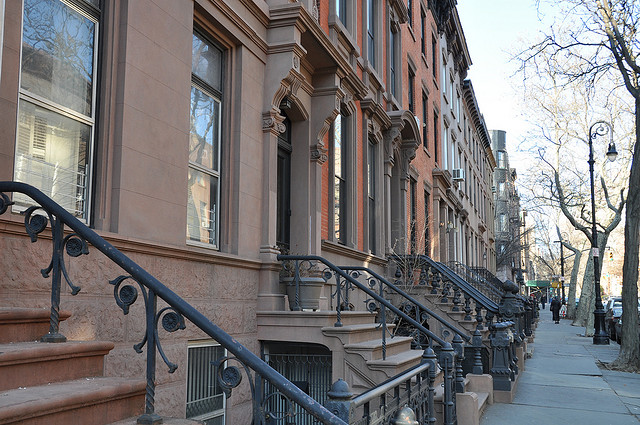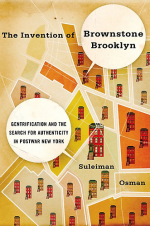
In Squaring Off, Zócalo invites authors into the public square to answer five questions about the essence of their books. For this round, we pose questions to George Washington University urban historian Suleiman Osman, author of The Invention of Brownstone Brooklyn: Gentrification and the Search for Authenticity in Postwar New York.
Osman’s history of “Brownstone Brooklyn” chronicles the transformation of blighted industrial neighborhoods into middle-class bastions of a mid-20th-century American Dream. He argues that the gentrification movement was one of the most important developments in modern urban history-changing cities on the ground and in our collective imagination.
1) You quote Truman Capote as saying, “I live in Brooklyn, by choice.” But wasn’t the primary motivation for most new Brooklynites financial?
 Which came first: the culture and politics of the chicken or the economics of the egg? Like many older American cities after World War II, Brooklyn had a ring of aging tenements and townhouses surrounding its downtown. Most planners and city leaders regarded this housing stock as “blighted” and hoped to raze it. Many working-class residents of these areas who lived in subdivided brownstones and rooming houses were also leaving the city for new suburbs. As a result, the housing in this brownstone belt was quite cheap in the mid-20th century. As the city shifted from a manufacturing economy to a service economy, more white-collar workers looked here for affordable housing. In the 1970s, renovating a townhouse was cheaper than building a new home. But the brownstone represented more than just cheap space. For new arrivals like Capote, Brooklyn’s brownstones represented an authentic place in contrast to sterile suburban tract homes and downtown apartment towers.
Which came first: the culture and politics of the chicken or the economics of the egg? Like many older American cities after World War II, Brooklyn had a ring of aging tenements and townhouses surrounding its downtown. Most planners and city leaders regarded this housing stock as “blighted” and hoped to raze it. Many working-class residents of these areas who lived in subdivided brownstones and rooming houses were also leaving the city for new suburbs. As a result, the housing in this brownstone belt was quite cheap in the mid-20th century. As the city shifted from a manufacturing economy to a service economy, more white-collar workers looked here for affordable housing. In the 1970s, renovating a townhouse was cheaper than building a new home. But the brownstone represented more than just cheap space. For new arrivals like Capote, Brooklyn’s brownstones represented an authentic place in contrast to sterile suburban tract homes and downtown apartment towers.
2) Is it ever really possible to find authenticity of place? If not, why do people keep searching for it in their communities?
Many geographers point to an instinctive human desire for a “sense of place.” People want to feel rooted, to feel spatially connected to memories, and to dwell in a “home.” This search for authentic place can be both progressive and reactionary. People have used the idea of an “authentic neighborhood” to fight against destructive development projects and environmental pollution. (Save Little Italy!) Others have fought to preserve a neighborhood’s authenticity by resisting the in-migration of African-Americans and other ethnic groups. (Save Little Italy!) Some geographers describe a sense of place that can be both dynamic and hybrid, a site of roots and a site of routes. In the 1960s and 1970s, baby boomers saw a world that was increasingly bureaucratic and alienating. Technocratic urban renewal czars were destroying the city with bulldozers and plans for prison-like apartment towers. The suburbs in their view were home to conformist white-collar men in look-alike tract homes filled with useless consumer goods. So many baby boomers looked for “real neighborhoods” in Brooklyn’s older industrial landscape. They called this “Brownstone Brooklyn.” In an era when middle-class New Yorkers were rejecting cities for the suburbs, this was quite progressive. But like all searches for authenticity, it was also problematic.
3) You mention neighborhoods in other cities that experienced gentrification from the 1950s to the 1970s-the French Quarter in New Orleans, the Castro in San Francisco. How was Brownstone Brooklyn different?

Brooklyn was not alone. In Manhattan, there was a similar story in the East Village and the West Side. With its emergence as a coastal center for both finance and the counterculture, San Francisco was perhaps most similar to New York City. But other areas were going through similar trends in the 1960s and 1970s: Washington D.C.’s Capitol Hill, Boston’s South End, Atlanta’s Inman Park, etc. Even smaller cities saw the phenomenon: Cleveland’s Ohio City, San Antonio’s King William, and Albuquerque’s South Martineztown, for example. Overseas there were cities like London, Toronto, and Sydney. In all these places, a new middle class began to move into and restore older houses and buildings, with a particular taste for Victorian-era housing. Interestingly, though, the places I mentioned are not historically remembered as sites of gentrification. They are famous as sites of other movements of the 1960s and 1970s: the antiwar movement, the counterculture, the environmentalist movement, the anti-expressway movement, etc. The links between these movements and gentrification in 1960s and 1970s is fascinating. It is also what made the relationship between brownstoners and poorer residents in these areas all the more complex.
4) Can you say more about not just socioeconomic but also racial complexities in these relationships? How does what happened in a predominantly African-American neighborhood like Bedford-Stuyvesant differ from the mostly white Park Slope?
Race is of course an important part of the story. Park Slope in the 1960s and 1970s, for example, was home to an interesting mix of longtime working-class white ethnic residents, newer African-American and Puerto Rican arrivals, and a growing number of young, largely white and liberal “brownstoners” who worked in white-collar professions and the arts. The book explores the coalitions and conflicts between these groups in neighborhoods like Carroll Gardens, Fort Greene, and Prospect-Lefferts Gardens over issues like redlining, blockbusting, school decentralization, urban renewal, rent control, machine politics, the McGovern presidential run, and the war in Vietnam.
5) Today, more and more neighborhoods have become part of Brownstone Brooklyn as prices have risen in neighborhoods that were originally gentrified in the 1960s and 1970s. Is this a continuation of a process the original brownstoners set in motion, or is it something entirely different?
One of my favorite things to do after finishing the book was to ask that question to longtime residents-black, white, Latino, homeowner, renter, wealthy, working-class-who have lived in Brooklyn since the 1960s and 1970s and were all participants in some way in the brownstoning movement. What do you think about Brownstone Brooklyn in 2011? Do you think it is a successful culmination of the trends that began in the 1960s and 1970s? Or has something gone wrong? Few have a single answer. It is amazing to see how familiar issues about race, class, neighborhood identity, authenticity, and displacement were being debated in Brooklyn’s brownstone districts even as far back as the 1940s and 1950s. There are differences, though. Today, the state is much more involved, the real estate industry and developers are key players, and there are a plethora of financial institutions eager to lend and invest in the area. In the 1960s, Brownstone Brooklyn was largely red-lined by banks, few insurance companies were willing to cover brownstones, real estate agents shunned the area because it was racially “mixed,” and the city was largely indifferent about brownstone renovation and more committed to urban renewal and slum clearance. There was a shift in the early 1980s as New York began to emerge from the fiscal crisis and real estate prices in areas like Park Slope began to soar. “Gentrification” entered the popular lexicon, and residents began a debate about the legacy of brownstoning that continues today. Was brownstoning creating authentic places or was gentrification displacing the poor? It was even more heated because it brought into the question the legacy of the cultural revolts of the 1960s. Was Brownstone Brooklyn a model of authentic city living? Or had the countercultural “authenticity” craved by baby boomers simply become yet another inauthentic commodity marketed by real estate agents?
Buy the book: Skylight Books, Powell’s, Amazon.
*Photo courtesy of Jay Woodworth.



